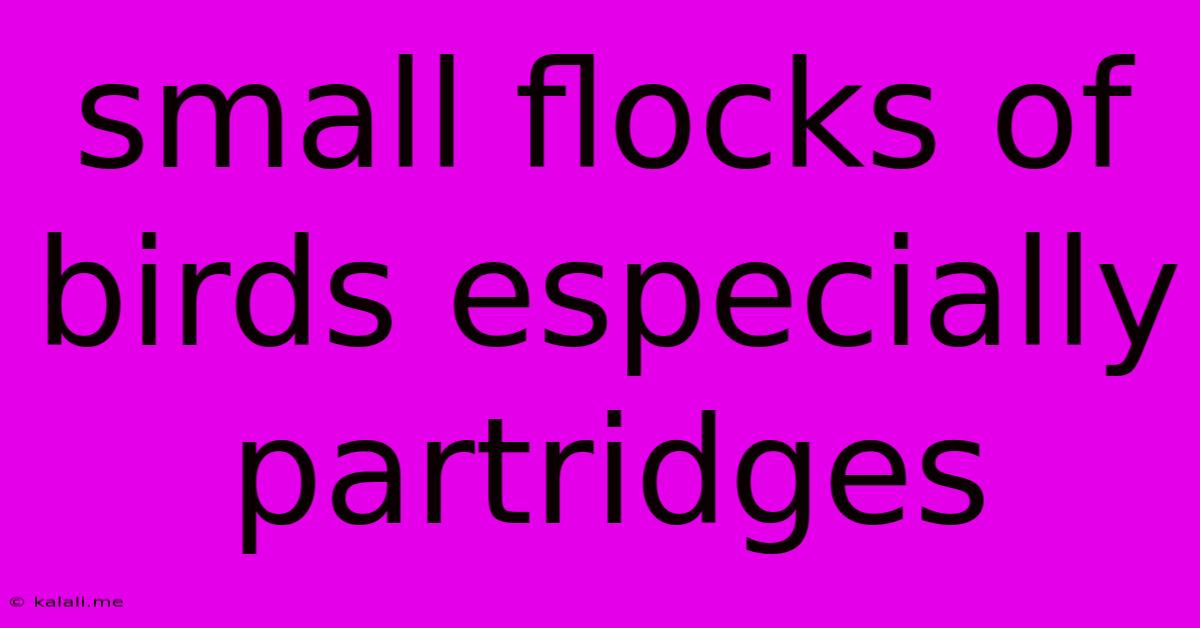Small Flocks Of Birds Especially Partridges
Kalali
May 20, 2025 · 3 min read

Table of Contents
The Enchanting World of Small Partridge Flocks: Behavior, Habitat, and Conservation
Meta Description: Discover the fascinating world of small partridge flocks! This article delves into their social behavior, preferred habitats, conservation status, and the unique challenges they face. Learn about the captivating lives of these often-overlooked birds.
Partridges, with their subtly beautiful plumage and elusive nature, often capture the imagination of birdwatchers and nature enthusiasts alike. While large flocks are sometimes observed, it's the smaller, more intimate gatherings that offer a unique glimpse into their social dynamics and survival strategies. This article explores the captivating world of small partridge flocks, focusing on their behavior, habitat preferences, and the crucial efforts towards their conservation.
Understanding Partridge Social Structures
Partridges are generally considered to be gregarious birds, meaning they exhibit a strong tendency to live in groups. However, the size of these groups varies considerably depending on the species, season, and availability of resources. While some species might form larger coveys during the non-breeding season for safety in numbers, smaller flocks, often family units or small cohesive groups, are a common sight. These smaller flocks provide several advantages:
- Enhanced Foraging Efficiency: Small flocks can cover a larger area when searching for food, increasing the overall foraging success rate.
- Improved Predator Detection: Multiple eyes and ears provide better vigilance against predators, allowing for quicker escape if danger is detected. A single bird's alarm call can alert the entire flock.
- Social Learning: Young partridges learn essential survival skills, like foraging techniques and predator avoidance, by observing and interacting with older birds within the flock.
- Protection of Young: Family groups often remain together for an extended period, providing parental care and protection for the young until they become more independent.
Habitat Preferences of Partridge Flocks
The habitat preferences of partridges vary widely across different species, but a common thread is a preference for areas offering a combination of cover and food resources. These birds often inhabit:
- Agricultural Landscapes: Fields of cereals, legumes, and other crops provide a rich source of food, while hedgerows and scrub provide vital shelter and nesting sites.
- Grasslands: Open grasslands offer foraging opportunities, but the presence of suitable cover, such as tall grasses, shrubs, or rocky outcrops, is crucial for protection.
- Woodland Edges: The transitional zone between woodland and open areas provides a balance of cover and access to foraging grounds.
Conservation Challenges and Strategies
Many partridge species face significant conservation challenges, including:
- Habitat Loss: Intensification of agriculture, urbanization, and deforestation have led to a dramatic reduction in suitable partridge habitats.
- Predation: Increased numbers of predators, both natural and introduced, can severely impact partridge populations.
- Climate Change: Changes in weather patterns can disrupt breeding cycles and food availability, negatively impacting partridge survival rates.
Conservation strategies often focus on:
- Habitat Restoration and Management: Creating and maintaining suitable habitats through initiatives like hedgerow planting, creating wildflower strips, and managing grasslands.
- Predator Control: Implementing carefully managed predator control programs where necessary.
- Sustainable Agricultural Practices: Promoting farming practices that minimize the impact on partridge habitats and enhance food availability.
Observing Small Partridge Flocks Ethically
When observing small partridge flocks, it is crucial to practice ethical birdwatching. Avoid disturbing their natural behavior, maintain a safe distance, and never attempt to handle or approach them closely. Respect their habitat and leave no trace of your presence. By adopting responsible viewing practices, we can contribute to the long-term conservation of these captivating birds.
By understanding the complexities of small partridge flock dynamics and the challenges they face, we can work towards ensuring the continued survival of these fascinating birds in our landscapes. Their presence is a testament to the richness and beauty of our natural world, and their conservation is a collective responsibility.
Latest Posts
Latest Posts
-
How To Erase Permanent Marker From Wood
May 21, 2025
-
How To Tell Bearded Dragon Sex
May 21, 2025
-
Washing Machine Valve On Or Off
May 21, 2025
-
What Size Drill Bit For Wall Plug
May 21, 2025
-
How Many Notes In The Musical Scale
May 21, 2025
Related Post
Thank you for visiting our website which covers about Small Flocks Of Birds Especially Partridges . We hope the information provided has been useful to you. Feel free to contact us if you have any questions or need further assistance. See you next time and don't miss to bookmark.